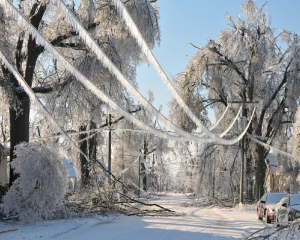FREEZING RAIN WARNING: A long-lasting period of freezing rain resulting in ice accumulation is expected or occurring.
BEFORE THE STORM:
ID Tag/Microchip:
Have your dog’s updated ID tags on their collar and the collar on them at all times during a storm. We recommend having your cell phone on your dog’s tag and that you have a dog licence from your municipality. Also, have your dog microchipped and the information kept up-to-date with the chip company/vets.
Long Walk:
Take your dog for a long walk as you both may be housebound for a few days.
Food and Meds:
Make sure you have enough dog food and medications in stock for both you and your dog. They recommend at least 72 hours worth.
Winter Dog Gear:
Get out your dog coats/sweaters and boots because when your dog has to go, they have to go. People will be using a lot of salt with this ice build up, so be prepared with dog boots or ointments to reduce the risk to your dogs pads. Have towels ready to dry off your dog after being out in the storm.
Evacuation:
Prepare ahead of time and have a plan for your family and your pets incase you had to evacuate your home. You can find a great article on planning ahead for your pets safety during an evacuation here. And disaster preparedness for pets here.
Have toys ready for indoor play:
Stuff kong’s with your dogs food or special treats, use interactive toys where both you and your dog work together, have chew toys ready: Your dog will be anxious and active and you will need to burn some of that energy off while indoors.
Print a copy of this list:
You can find a copy of this list for printing here.
DURING THE STORM:
Only outside for bathroom breaks:
Limit the time you and your dog spend outside during the worst of the storm. Ice makes the streets and sidewalks dangerous and the storm itself may cause havoc. Don’t forget your own cleats for your boots as everywhere you step will be icy. (Information on hypothermia in dogs can be found here.)
Leashed when outside:
Please keep them on leash, even within a fenced yard during the storm. Winds, heavy ice build up, noise of salt trucks, falling branches, etc. All these things can cause your dog to bolt. A dog bolting from fear can leap high fences and/or run for long distances.
Power Outage:
Stay calm so your dog stays calm as well.
Don’t forget to keep your dog warm by providing them with blankets or sweaters.
Speak out if you see a pet left in the cold:
Call your local Animal Control or the Provincial SPCA Cruelty Investigations to report a dog left out in the cold. You could also try your local Police or RCMP. Contact Information listed by County for Nova Scotia can be found here: www.ns.lostdognetwork.com/contact-list/
AFTER THE STORM:
Before you let your dog out, check your yard:
Thoroughly check the yard after the storm for any open gates, broken fence sections, hanging or downed branches/trees, power lines down, downed live wires, etc.
Road Salts:
After a snow storm the sidewalks may be very icy and/or covered in road salt. “When you get back inside, wipe down (or wash) your pet’s feet, legs and belly to remove these chemicals (road salt) and reduce the risk that your dog will be poisoned after (s)he licks them off of his/her feet or fur.”*
___________________________
* AVMA Cold Weather Pet Safety: https://www.avma.org/public/PetCare/Pages/Cold-weather-pet-safety.aspx



I’M happy to see this post. People need to be reminded to take precautions. Ounce of prevention is worth a pound of cure (A dog warm and safe at home is far preferred to one out lost, cold and alone in a storm).
Thanks Anne!